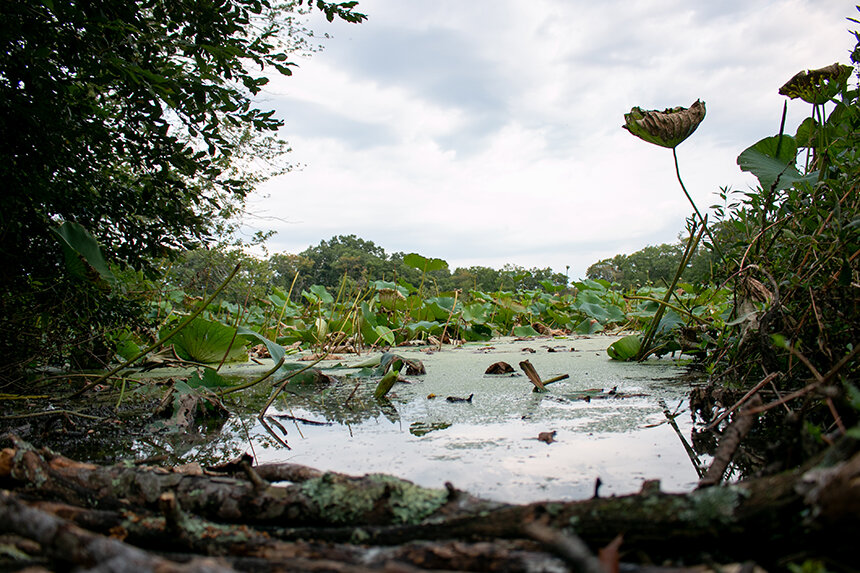Originally published by ecoRI News, a nonprofit newsroom covering environmental news in Rhode Island. Read more at ecoRI.org
SOUTH KINGSTOWN — Indian Lake doesn’t look like the site of an alien invasion.
Just off Route 1 in Washington County, the 260-acre lake could be any of the hundreds of freshwater lakes, ponds, swimming holes, and rivers that are popular Rhode Island summertime destinations. Indian Lake boasts clear waters, and a maximum depth of only 10 feet, making it a popular destination for swimming, boating, and fishing.
It’s popular with both out-of-state tourists — a handful of rental properties surround the lake — and year-round locals, with public access concentrated at a boat ramp and fishing spot along the lake’s southern shore.
But beneath Indian Lake’s placid and peaceful waters, a silent invasion is going on that threatens to wipe out the native aquatic wildlife and plants that call it home.
It’s called hydrilla verticillata, and it’s not from Mars, but it is probably from Connecticut. First found in Indian Lake by the Rhode Island Department of Environmental Management last August, hydrilla is a highly aggressive aquatic invasive plant, often referred as “the perfect aquatic weed” because it spreads aggressively, grows quickly, and is difficult to remove from the waters it infects.
“It can really outcompete the native plants,” said Katie DeGoosh, an environmental scientist in DEM’s Office of Water Resources, in an interview with ecoRI News last fall. “Hydrilla is very tolerant of low light conditions or dark conditions. It can start photosynthesizing earlier in the morning than our native plants, and it can suck out the carbon dioxide that our native plants use.”
Pulled out of the water, hydrilla resembles any other weed a person might find in their garden; it has thick roots, long stems, and whorls of leaves with pointed tips. It grows rapidly, up to a foot a day in some cases. Left untreated, the plant can literally crowd out all other aquatic vegetation, eventually impacting the habitat structure of the water column for frogs, turtles, and fish.
And it’s spreading. Since the original DEM announcement about Indian Lake in September, hydrilla has spread to two additional bodies of water: Lake Mishnock in West Greenwich and South Kingstown’s Worden Pond.
Hydrilla was originally identified in the Connecticut River in 2016, in Glastonbury, Conn. A survey conducted in 2019 and 2020 reported 774 acres of hydrilla infesting the river, from Agawam, Mass., to Long Island Sound. Local marinas and municipalities reported access to boat slips and docks became impossible due to the severity of the river’s hydrilla infestations.
Similar to other invasives such as variable millfoil and fanwort, hydrilla spreads via fragmentation; simply put, any piece that breaks off from the main plant can grow into its own organism. It’s also great at hitchhiking; boaters spread invasives like hydrilla if they don’t clean off their boats properly before launching it in another body of water. Pinpointing the source of invasives in newly infested waterbodies is tough to do, but it’s likely hydrilla spread into the three ponds this way.
“The most efficient and cost-effective management strategy to control aquatic invasive plants is to prevent the plants from [getting] to, and becoming established in, a waterbody,” DEM spokesperson Evan LaCross said.
Earlier this year, DEM was awarded a $133,392 grant from the U.S. Fish & Wildlife Service to start chemically treating Indian Lake for its hydrilla infestation. LaCross said DEM’s two strategies would be controlling the current population of the invasive within the pond and containing it from spreading to other bodies of water throughout the state. The agency will work with the town of South Kingstown to treat the lake.
This summer, LaCross said, DEM will also staff the boat launch part-time, 20 hours a week, to help boaters clean off their gear as they pull it from the water. A 1-inch hydrilla fragment clinging to a boat’s hull is all that’s needed to start new infestations of the invasive in other freshwater bodies.
DEM expects treating the invasive to be a multiyear effort. LaCross said it was possible to control hydrilla within 7-10 years with consistent monitoring and chemical herbicide treatments.
As time goes by, aquatic invasive species pose a bigger and bigger problem to the state’s fresh waters. As of last November, there were 112 ponds and lakes and 29 river segments in Rhode Island with at least one species of invasive plant. And many of them host more than one species.
Hydrilla isn’t the only thing lurking in Indian Lake, for example. The lake also has infestations of water hyacinth and American lotus, and has recorded multiple instances of blue-green algal blooms over the past few years.
Last year, DEM’s Division of Agriculture and Forest Environment processed applications for 19 lakes larger than 10 acres for herbicide permits to treat aquatic invasives, about 1,860 acres of fresh water.
The most successful alien invader in Rhode Island’s waters is variable millfoil, an underwater weed with fine, densely packed leaves that resemble feathers, whorled around a main stem. In summer, stems can poke above the waterline between 3 and 6 inches. In Rhode Island it’s been reported in 61 lakes or ponds, and 20 river and stream segments.
Milfoil in its original habitat — in the Midwest and southeastern United States — is a vital food for insects and fish, which feed on the plant and control its growth. But no such predators exist for the plant in Rhode Island. Like hydrilla, it can grow rapidly, up to an inch a day, in sub-optimum conditions for temperature, light, and nutrients. It was first documented in New England in 1932, in Bridgeport, Conn., and since then it’s become established in every state in the region.
In addition, the rising temperatures of climate change favor invasive species over native ones. In the past, snowy winters resulted in ponds and lakes icing over, depriving invasive plant species of much-needed sunlight, and causing them to die off. But milder winters, with less snow and ice, mean species like hydrilla can grow and germinate earlier in the year.
Of the 37,000 invasive species reported in the United States, 37% have been found since 1970, powered by increasing human trade and travel around the globe, according to a report released last year by the Intergovernmental Science-Policy Platform on Biodiversity and Ecosystem Services for the United Nations.

Invasives have taken root so deeply in Rhode Island largely because treating the waterbodies is complicated. Infestations of hydrilla can take repeated, careful chemical treatments for up to a decade before the invasive is considered successfully contained.
The state’s invasive species plan, written in 2007, only identifies the Coastal and Estuarine Habitat Restoration Trust Fund operated by the Coastal Resources Management Council as a source of funding for treating aquatic invasive species, but it’s likely to be insufficient to handle the treatments needed for invasives, as it’s budget for 2022 clocked in at less than a quarter of a million dollars.
Meanwhile, for DEM, the state’s chief environmental agency, it’s another case of no money, more problems. Of the 112 lakes and ponds with at least one invasive plant, 67 are bigger than 10 acres and have public access areas maintained by DEM, either at fishing spots or boat launches, about 7,577 acres of aquatic habitat total.
DEM estimates actively managing the infestations would cost the department between $3.8 million and $7.6 million annually — money it doesn’t have to spare within its current budget.
Residents have started to fight back. Earlier this year advocates from Save The Lakes, a Chepachet-based nonprofit dedicated to protecting Rhode Island’s fresh waters, and members of various lake and pond associations flooded the General Assembly with support during a number of committee hearings on bills to juice the state’s resources for treating aquatic invasives.
“We’ve had an ongoing problem with invasive weeds for years now,” said Deb Silva, president of the Sand Dam Reservoir Association, at a Senate Environment and Agriculture Committee hearing last month. “We have a state boat ramp, and the state does not help us at all.”
Silva told the assembled lawmakers the 39-member association hires a company every year to treat the aquatic invasive species found within the reservoir, variable milfoil. In 2021, it paid $28,000 to treat the pond, money which had to be fundraised. “Our problem is we do the treatment, we get rid of the invasives and then at the boat ramp they get right back in again,” Silva said. “We can treat in June, and by August, we’re reinfected again.”





